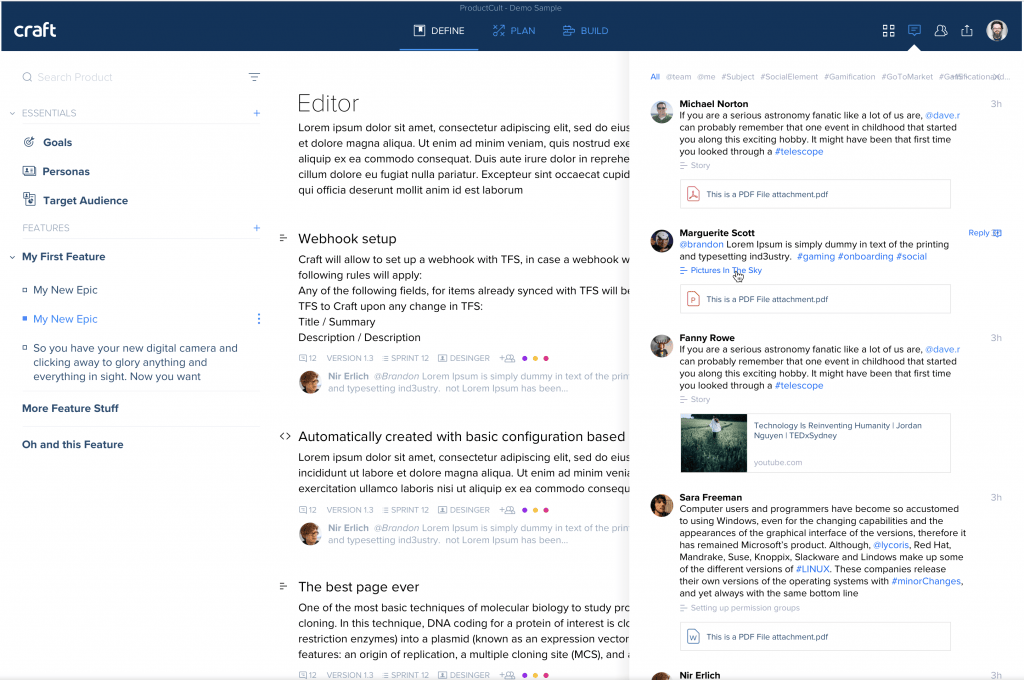Home > Blog > Why a Distributed Product Team is Better
Why a Distributed Product Team is Better

The Craft team is as distributed as it gets. We have teams in Tel Aviv, Kiev, Silicon Valley and more. Some teams collocate in local offices, while other team members work from their homes/cafes/tree-house. The time-zones are a gorgeous patchwork of AM/PMs, ESTs and PSTs. In short: geographically – we’re all over the place, work-culturally – we’re a powerful, closely-knit, ninja-defeating force.
I took some time to reflect on what makes the Craft team so productive and together-minded despite the geo-location distribution and came to an interesting conclusion:
- It’s always been about the people, not the geography (Shocker, right?)
- Working remotely is actually not a challenge, but an advantage.
I wouldn’t blame you for thinking that last part sounds like a self-motivating slogan. But it is not. It is the a real, calculable, rooted-in-reality truth, and here’s why:

The case for distributed teams
I’d like to start by making the case for working distributedly, and rather than tearing down collocation in one office, as is often the case in pieces like this – I’m going to tell you why distributed teams are better:
Multi-locations means diversity – a global team means the coming together of minds from different countries and cultures. Apart from the essential value of building a diverse team, diversity brings tremendous added value to a global product like Craft: the interaction between team members from different cultures creates the need to expand and improve your communication skills.
In order to always be on the same page, we need to learn new culturally unique expressions and terms; we are always attentive and patient in conversation, to ensure everyone is understood and can express themselves comfortably; we pick up words in new languages and expand our geographical familiarity with places we’ve never been to.
In addition to building a culturally-diverse and well-rounded team, this dynamic contributes greatly to customer care and user management. Not to mention a wider understanding of our user base, which is a priceless asset when it comes to UX planning and new product strategy.

Diversity (source)
Absence makes the heart grow fonder
This came as quite a surprise to me, but it turns out that when team members do not share the same work space, they develop a more imminent eagerness to be in touch and stay updated.
The reason for this, I believe, is good old FOLO. Since we’re not physically connected to a hub of work and information, we are proactively go after it. And since I build my product teams only with independent, proactive professionals – I can be certain this initiative-driven communication is rooted in curiosity and dedication, rather than insecurity or apprehension.
Digital communication is always more efficient
Not to be confused with “mechanic”, “laconic” or “impatient”, what I like about our team’s communication is that everyone is always trying to get the clearest, most concise message across.
We can’t just toss a link into Hangouts and then walk over to another desk to explain it. This means thinking everything through, not compromising on being articulate and using the most accurate terms to describe your idea or need.
This kind of written culture should be fostered, I believe, everywhere. But not every company has the need for it, so many work cultures fall into a kind of neglectful communication which eventually impacts their very capacity for productivity. Use less words, but make sure they’re the right ones, mean everyone of them.
Don’t let a trifle like geography limit your team’s potential
If the best person for the job happens to live 8 time zones away, then let’s add a clock to the schedule planner and change the time for the weekly call. We are enormously privileged to be able to take for granted the ability to work with people in other continents on a daily basis. So let’s just do that.
Keeping the Loop Alive and Kicking
That still leaves us with the not-so-minor matter of communication re: meeting goals and making progress. Since not everyone can be present at the daily stand-up meeting, we have to set up alternative channels of communication, structured and firmly grounded in routine and work processes.
This is important to ensure that team members are getting stuff done, and if they are not – to make sure they get all the help they need or revisit goals and deadlines. It offers a definitive point in time, supported by an entire weekly cycle for which is really important when you don’t work in an office environment:
Weekly calls are also highly instrumental in providing a sense of realness and connection between team members. Not to diss the merits of written communication, but hearing someone’s voice or seeing them on the screen adds a layer of substance and context that no IM chat can.
Creating a Sustainable Company Culture
Part of the glue that allows team members to work comfortably together from afar is establishing a positive, sustainable company culture. Collocated teams can do that with daily office rituals, Happy Hours on Fridays or paintball escapades.
Distributed teams need to come up with creatives ways around that. One of those ways is by constant updates and celebrating small triumphs together. When we get superb reviews from customers – I always make sure to message the whole team and credit the team members who had a role in this success. Welcoming new team members in the right Slack channel is also critical for keeping everyone in sync and connected.
Another aspect of distributed team building is, of course, sharing work experiences. To compensate for a lack of familiarity with the same space, I try make sure to post team selfies with different parts of the team. Again, this does wonders in establishing a familiarity and a human-toch realness that would otherwise be very absent.
It’s important to encourage different team members to work together. Everyone needs to establish their own dynamics and cooperation framework independently, just like they would in an office environment.
Invest in Collaboration and Team Communication Software
It’s probably time to address the million dollar dilemma: is it better to insist on a single channel for team communication or should everyone use whichever channels they prefer?
For ongoing work communication, we have Craft. It is obviously more convenient to communicate about something in context and Craft allows you to create different teams in-app for different purposes. You can tag/mention someone to get their attention or address a certain point; upload images and links and use hashtags.
For any other kinds of communication, or discussions with members from other teams, I’m content with everyone communicating however they see fit: Slack, Hangouts, Skype, Email, WhatsApp. As long as everyone is organized enough to find their content and keep track of documentation and files – I don’t care if they use smoke rings or carrier pigeons.

Summary
The greatest single challenge to a distributed team is trust building, and the only way to overcome that is creating that sense of familiarity in different channels that have to compensate for not being able to shake someone’s hand or read their facial expressions clearly.
I have great respect for Google’s approach to team-building. In particular, I find this is a very accurate, eloquent way to phrase a crucial element in the process:
“Team members (need to) feel safe to take risks
and be vulnerable in front of each other”
Gather your team! Craft’s tool for product planning is designed to flow seamlessly with Agile process


